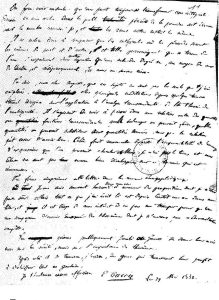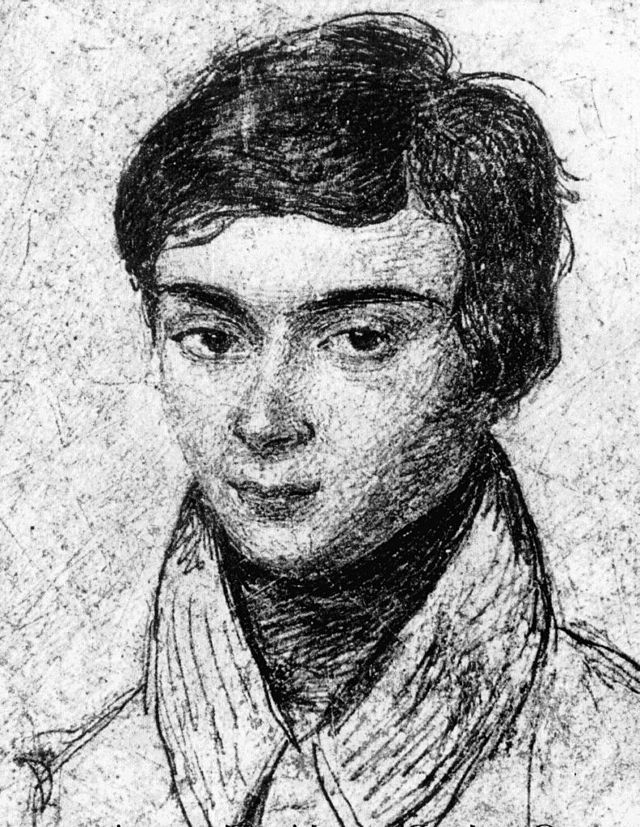In the dim light of history, certain voices echo louder than others, demanding our attention. One such voice belongs to Évariste Galois, a brilliant French mathematician whose legacy took years to truly unfold. He is renowned for his groundbreaking contributions to abstract algebra, which laid the foundation for modern algebraic mathematics.
His life and legacy are an intricate tale of brilliance, struggle, and tragedy. Galois’ remarkable mathematical journey was intertwined with personal hardships and political turbulence, shaping both his career and his destiny. Despite his untimely death at the age of 20, Galois left an indelible mark on the fields of mathematics, including his groundbreaking contributions to abstract algebra, which laid the foundation for modern algebraic mathematics.
Early Life
Évariste Galois was born on October 25th, 1811, in Bourg-la-Reine, France. He was the first-born son of Nicolas Gabriel Galois and Adelaide Marie, with one older and one younger sister. Born as a middle child of the three Galois children, he was educated by their mother Adélaide-Marie when he was young.
When 12-year-old Evariste Galois enrolled at the prestigious Lycée Louis-leGrand, it marked a significant shift from his sheltered home education by his well-informed mother. The school, which was entrenched in traditional values, imposed rigorous regulations as students were required to wear uniforms, had minimal food, and faced strict limitations on speaking and exercise. For Galois, who was accustomed to a more lenient environment, these stifling rules most likely suppressed his unique creativity.
However, Galois still managed to fall in love with mathematics, which was far from his family’s profession: politics. His competence was much higher than his companions and he devoured Legendre’s Elements of Geometry, reading it like a novel, and he soon put aside textbooks to devote himself to studying the original works of Lagrange, who was an Italian mathematician, physicist, and astronomer. His teachers were discontented by his attitude saying, “He is under the spell of the excitement of mathematics. I think it would be best for him if his parents would allow him to study nothing but this.” Nevertheless, it was undoubtedly from Lagrange that Galois first learned the theory of equations, to which he would later make significant contributions to the field over the following four years.
In 1828, his great ambition led him to try for an early entry into the École Polytechnique. Unfortunately, despite his intelligence, he failed without the necessary training.
His second attempt to get into Polytechnique was also unsuccessful. One part of the exams was an oral test where the students were quizzed by two professors of the institution. But Galois’s habit of working entirely in his head put him at a serious disadvantage before a blackboard. During the oral exam, one of the professors proposed to argue a mathematical point with Galois. It was a heated argument; however, the professor could not understand Galois’s explanation. Ultimately, Galois lost his temper and threw the eraser at the professor’s face. Suffice to say, that was the end of his attempt to get into the Polytechnique.
Although he published several works in his life, his greatest contribution remained blocked at the gates of the French Academy, first by Cauchy. Augustin-Louis Cauchy was a French mathematician, engineer, and physicist. He was one of the most renowned mathematicians in the French Academy of Sciences, an assembly of scientists chosen among the most distinguished specialists. However, when Galois sent his work to this great mathematician, Cauchy wrote that he could not present his work because he was ill. Yet, he advised him to send his work to Fourier, a mathematician and physicist, and also a secretary of the Academy.
However, his misfortune struck again as Fourier died a few days later after receiving Galois’s work. This resulted in the loss of his manuscript. This manuscript solved a century-old problem, demonstrating the conditions necessary and sufficient to solve polynomial equations by roots.
In 1831, Galois made his third attempt to present his groundbreaking memoir on the theory of equations to the Academy. Unfortunately, the judges, including prominent mathematician Siméon-Denis Poisson, failed to grasp the ideas that Galois presented. They incorrectly perceived his work to contain a significant error and were resistant to accept his original and revolutionary mathematical methods. Once again, Galois was unable to gain acceptance for his revolutionary ideas in the conservative academic environment of his time. Unfortunately, this was his final attempt to receive recognition when he was alive – his main achievement would not see the light until after his death.
Political Involvement and Turmoil

19th century France was a time of political unrest. In 1830, the July Revolution led to the exile of the last Bourbon monarch, Charles X. However, the republicans were deeply disappointed when Louis-Philippe, often referred to as the “Citizen King” due to his support for republicanism and display of revolutionary symbols, took the throne. He ruled from 1830 to 1848; despite his initial promise, his reign did not fulfill the republican aspirations of the time.
After his father’s death in 1829, Galois enrolled as a student teacher in the less prestigious university, École Normale Supérieure, and turned to political activism. Galois, however, realized that the director of the institution sided with extreme royalists and threatened to call the troops if the students tried to join the revolution. As a passionate republican, Galois expressed his pro-republican views in a bold article, severely criticizing the director. Eventually, he was expelled from the institution.
After his expulsion, he was arrested twice for his republican activities. His first arrest was due to the accusation of him speaking against Louis-Philippe. During this period of life, his political beliefs grew stronger and stronger. He joined the National Guard, which was intended to serve as a “city guard,” defending Paris from outside threats and upholding law and order in the nation’s capital. It was to be autonomous from the army, not subject to the king, and, above all, devoted to the revolution. Unfortunately, as soon as he joined the army, the organization was disbanded by the King due to the fear that they might disrupt the government.
In response, the members of the Republican organization held a banquet. At some point, Galois stood up to make a toast, saying, “To Louis Philippe,” and holding a dagger over his cup. The republicans applauded, taking Galois’s toast as a challenge to the king’s life. The next day, he was taken into custody at his mother’s home as he was charged for opposing to the monarch. He was imprisoned at Sainte-Pélagie jail until his trial. Galois cleverly defended himself by asserting that he said, “To Louis-Philippe, if he betrays,” but his words were simply lost in the applause. The jury let him free, but his freedom did not last long.
On the infamous Bastille Day on July 14th 1831, Parisians, hungry from a poor harvest and enraged by the king and government for their mistreatment, finally took up arms and marched toward the Bastille, a historic Royal fortification. Leading the protest was Galois, who was heavily armed with a loaded rifle and multiple pistols. He was arrested once again. Months later in October, he was sentenced to six months in prison. He continued his passion in mathematics even in the cold prison cell and was released in 1832.
His Last Breath

Sadly, his promising future in mathematics was cut short when he died at the young age of 20, due to a duel related to his political activities. Brutally wounded in the duel, he was abandoned in a field. He was found by a peasant and taken to a hospital, but died of an infection after a few days.
There are various theories about why the duel was called: that Galois was lured into the duel by a state secret agent, that it was a duel called between fellow republicans, or that it was to settle a love dispute between Galois and Perscheux d’Herbinville (a rumored friend of Galois) for the daughter of the prison physician, Stephanie-Felice. The truth is, we don’t know – but we do know that Galois wrote two letters the night before the duel.
In one, addressed as a “Letter to all Republicans,” Galois wrote, “I beg patriots and my friends not to reproach me for dying otherwise than for my country. I die the victim of an infamous coquette. It is in a miserable brawl that my life is extinguished. Oh! Why die for so trivial a thing, die for something so despicable! Pardon for those who have killed me, they are of good faith.”
During the night before the duel, Galois spent hours “filling in the gaps” in some papers he had previously submitted to the French Academy, but which had been rejected because he had not provided sufficient proof of his results. He sent this seven page letter containing new theorems he found to his friend, Auguste Chevalier. In places, he scribbled in the margins: “I have not time; I have not time,” and passed on to the next frantically scrawled outline. This frantic endeavor highlighted both his mastery in mathematics and the immense pressure he felt to announce his mathematical concepts before it was tragically cut short.
Galois Theory and Mathematical Legacy
Now, in the world of mathematics, where abstract concepts often baffle even the most astute minds, Galois Theory stands as a beacon of brilliance and innovation.
What makes Galois Theory truly remarkable is its elegant approach to understanding the roots of polynomial equations. The key concept in Galois Theory is the notion of a “group,” which mathematically captures the symmetries and transformations of an object. For a given polynomial equation, the Galois Theory associates a specific group, known as the Galois group, which describes all the possible permutations of the roots that preserve the structure of the equation. The solvability of the polynomial equation is intimately connected to the properties of its Galois group. If the Galois group has certain symmetries, the polynomial equation can be solved using radicals. However, if the Galois group lacks these symmetries, there is no general solution in terms of radicals.
By associating algebraic symmetries with the solvability of equations, Galois Theory unraveled the mysteries that lie beneath seemingly complex mathematical problems. It boldly asserted that there is no general solution in radicals for polynomial equations of degree five or higher, offering a definitive answer to a question that had puzzled mathematicians for centuries.
Today, Galois Theory’s profound implications extend far beyond its theoretical beauty, finding practical applications in cryptography, coding theory, and even physics, illuminating the path for scientists and engineers to explore uncharted territories in the digital age. Galois Theory continues to serve as a guiding light, inspiring generations of mathematicians and scientists to push the boundaries of what is possible. Through Galois’s lens, the mystifying world of numbers becomes clearer, unveiling a universe of infinite possibilities and profound connections, proving that even in the abstract corridors of mathematics, there lies a harmony waiting to be discovered.
Through Galois’s lens, the mystifying world of numbers becomes clearer, unveiling a universe of infinite possibilities and profound connections, proving that even in the abstract corridors of mathematics, there lies a harmony waiting to be discovered.

